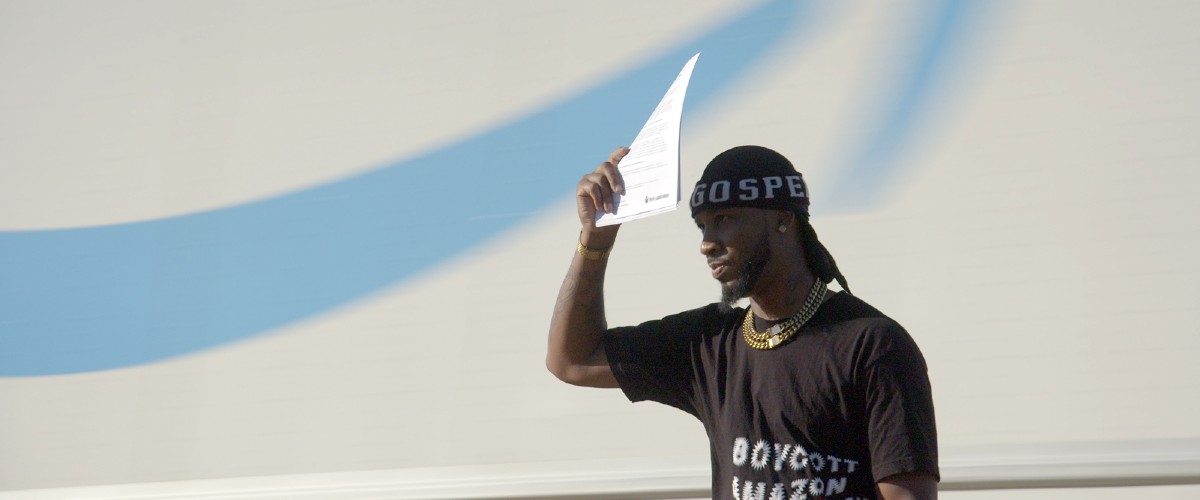Movie Reviews
‘HWJN’ Review: A Colorful Application of Traditional Arab Mythology to the Modern World

We’ve had genies of the playful, wish-granting “Thief of Baghdad” type, and more recently quite a number of evil djinn in horror movies. But it’s hard to recall a prior screen portrait of the same malleable Arabic mythological creatures quite like “HWJN,” which takes the cuddlesome, anthropomorphic “They’re just like us, only magical!” view of Pixar animations and such in depicting modern-day jinn (the term’s more accurate translation) who invisibly live alongside humans.
Yasir Alyasiri’s visually appealing fantasy, which kicked off the Red Sea Film Fest, is at times too innocuous in tone and pedestrian in story ideas. But it’s nonetheless a slick, pleasant diversion that should attract viewers eager for an approximation of CGI-heavy western family entertainments, albeit with up-front Arabic cultural and Muslim religious emphases. The Saudi Arabia-United Arab Emirates coproduction opens commercially in S.A. on Jan. 4.
Drawn from sci-fi author Ibraheem Abbas’ popular (if sporadically banned) series of novels, which began publishing a decade ago, this amiable whimsy starts off its world-building immediately in the most straightforward terms. Our narrating protagonist Hawjan (Baraa Alem) is introduced watching a traditional “evil genie” film in a cinema. He protests such stereotypes, insisting that real jinn “have jobs, families and family drama,” just like the humans they co-exist with. Only the humans don’t know it, because “God separated our worlds for a reason of which He knows best,” rendering jinn capable of seeing humans but not vice versa. Interaction between the two is difficult, and forbidden by the “jinn creed,” anyway.
Nonetheless, it becomes hard to maintain that detachment once the abandoned home that young doctor Hawjan (at 92, he looks 20) shares with his mother and grandfather on Jeddah’s outskirts is refurbished, then inhabited by the well-off Abdulraheems. Only daughter Sawsan (Nour Alkhadra), a med school student herself, senses the presence of the preexisting supernatural residents even faintly. Our hero is quickly smitten, so he works assiduously to create a communication bridge with her — which takes the form of a shameless plug for iPads. But their inter-dimensional relationship is problematic, to say the least. For one thing, she’s already got a nice, safely human beau in classmate Eyad (Mohsen Mansour). For another, she has a brain tumor that may render any romantic or marital prospects moot.
But worse still is that fatheress Hawjan, whose paternal background (and reasons for being “trapped” living alongside people) have been kept from him, is in fact jinn royalty sought for nefarious purposes by minions of the wicked King Hayaf. Chief among them is chrome-domed Master Xanaam (Naif Al Daferi), a cousin who to save his own neck must persuade our hero to marry his sister, the beauteous Jumara (Alanoud Saud). In order to do so, he and his flunkies cast a spell on Sawsan, using her already vulnerable health as an instrument of blackmail. To save her life, and fulfill his own destiny, Hawjan must journey to the fantastical lands of two warring jinn tribes.
Even if these desert realms recall the various versions of “Dune” in their tawny look, it is in sequences set there that “HWJN” is most enjoyable. Indeed, these flights of visual fancy — handsomely realized by production designer Khaled Amin, costumer Hassan Mustafa and DP Nemanja Veselinovic’s frequently amber-hued cinematography — prevent the rather banal Earth-bound conflicts from dragging “HWJN” into tearjerking melodrama.
The pacing sometimes plods a bit, but likewise is juiced enough by regular infusions of eye candy to maintain interest. Even human interiors are granted a colorfully inviting warmth, and some spectacular desert exteriors were shot in Egypt. Less distinctive is Khaled Alkamaar’s original score, which is a little too squarely faithful to the John Williams school of triumphal, fully orchestrated western mall-flick soundtrack themes.
Well-cast performers ably fulfill the demands of their fairly one-note roles, from our puppyish protagonist to various concerned parental figures and an assortment of comical or sinister grotesques. Unsurprisingly, the door is left wide open for sequels, with supervillain Hayaf — his ghoulish countenance glimpsed only at the fadeout — not about to take everybody else’s happy endings like a good sport.

Movie Reviews
'Killer Heat' movie review: A mystic mystery

Philippe Lacôte’s Killer Heat is a suspense thriller set on the tranquil island of Crete, Greece. The island’s stunning landscape, with rugged mountains and pristine beaches, creates the perfect setting for this atmospheric mystery. Initially, the film may feel too laid-back for its own good, but as the plot unfolds, it finds its groove, delivering a cohesive, engaging story. Much like its setting, Killer Heat is refreshingly straightforward, avoiding a forced sense of suspense. The mystery unravels at a measured pace, allowing the viewer to savour the journey.
The plot itself may not break new ground, with relatively low stakes, but what makes it work is the absence of unnecessary storytelling shortcuts. Joseph Gordon-Levitt plays Nick Bali, a private investigator hired to look into the mysterious death of Leo (Richard Madden), the heir of the wealthy Verdakis family.
The film opens with Leo climbing a cliff while Bali narrates the Greek myth of Icarus, the man who flew too close to the sun. Leo soon falls to his death, and the family—except for Leo’s sister-in-law, Penelope (Shailene Woodley)—considers it a tragic accident.
Penelope, however, is convinced otherwise, refusing to trust the local police, claiming her “family owns them”, and that “in Crete, no one goes against the gods”. The film’s integration of Greek metaphors adds a touch of mysticism.
What’s refreshing about Killer Heat is that it doesn’t trick the audience. From the first scene, it’s clear that the culprit isn’t an outsider, but that doesn’t take away from the suspense.
Movie Reviews
Union movie review & film summary (2024) | Roger Ebert

When Amazon workers on Staten Island successfully voted to unionize in the spring of 2022, becoming the corporate retailer’s first American workplace to do so, it was hailed as one of the most important labor victories in the United States in nearly 100 years.
For the Amazon Labor Union (ALU) to organize employees at the JFK8 warehouse to vote in favor of union representation was a David versus Goliath story for the age of globalization — and a rousing reminder that collective grassroots efforts can still succeed despite massive employer concentration, management intimidation, and other hindrances to building worker power. And that an independent, worker-led coalition led the drive at this 8,000-plus-employee facility, rather than an established union, made its victory all the more impressive, even as the vote to unionize brought organizers into uncharted territory and set up a protracted legal battle with Amazon, which has since refused to recognize the ALU or negotiate a contract.
Telling the story of how the ALU reached this historic moment, “Union,” a new documentary co-directed by Brett Story (“The Hottest August”) and Stephen Maing (“Crime + Punishment”), takes a detail-driven, ground-level approach, following current and former Amazon employees in Staten Island as they mount a grassroots worker-to-worker campaign, standing their ground against one of the world’s powerful corporations all the while.
No talking-head documentary but a keenly observational chronicle of the unionization push and its aftermath, “Union” often plays like a thriller by virtue of its sharp, smart editing rhythms. Early on, Story and Maing juxtapose Jeff Bezos blasting off into space on a rocket made by his Blue Origin company and Amazon workers trudging wearily into work; it captures the unimaginable scale of the company’s operations while foregrounding the human scale often concealed by breathless (yet inevitably compromised) reporting of Amazon’s designs on empire.
Made over the course of three years, Story and Maing’s film explores the human cost of the convenience economy and illuminates oppressive working conditions in Amazon’s factories. From constant surveillance to high injury rates and a lack of breaks, the pressures of working in Amazon warehouses compound to create punishing environments for workers, ones Amazon has steadfastly refused to address or even accurately report. And the threat of retaliation against workers who organize is ever-present; in addition to pouring hundreds of millions of dollars into union-busting campaigns that include mandatory “captive audience” meetings (which have since been banned in the state of New York), Amazon issues warnings of possible termination to workers involved with the unionization drive.
Bookended by footage of vast cargo ships transporting goods, a reminder of the slow, perpetual motion with which the gears of modern capitalism grind on, Story and Maing’s film is smart in how systematically its narrative lays out obstacles to the union’s success. It also insightfully depicts ground-level dialogue between workers as a powerful tool with which to overcome them. Some of the most remarkable footage, inside Amazon headquarters, covertly films one of those captive audience meetings; here, the company’s anti-union propaganda (One reads: “We’re asking you to do three simple things: get the facts, ask questions and vote no to the union”) is disrupted by ALU organizers, who successfully push back on Amazon managers just long enough to make their case to workers.
One of the ALU organizers, Chris Smalls, takes center stage in “Union,” though the documentary largely sidesteps the temptation to cast him as a conquering hero. (That’d be an easy trap, given that he became the organization’s public face across the period “Union” depicts.) Smalls, fired from Amazon after protesting inadequate PPE provision during the pandemic (and besmirched by the company’s general counsel as “not smart or articulate” in an internal meeting of executive leaders), is a father of three who was moved to activism by the flagrant injustice of the company’s abusive labor practices. As a leader, he’s at once charismatic and hard-charging, dedicated to his fellow “comrades” but ever driven to push forward even in the face of inter-union dissent.
One of the film’s great strengths is its ability to surface the multiplicity of tensions between organizers working toward a shared cause. Take the world of difference separating the experiences of two subjects: Maddie, a white college graduate using her campus activism experience to help the cause, and Natalie, an older Latina woman living out of her car for years. In one charged exchange, Natalie pushes back on the suggestion, made by white male organizers, that Chris intentionally gets himself arrested by New York police officers to draw attention to the unionization drive. Ultimately, Natalie’s dissatisfaction with the ALU—due to her disagreements with leadership as much as her desire to wait for larger union support—leads her to leave the organization. It’s a testament to the complexity of individual motivations and the absence of easy triumph in this type of effort.
“Union” documents the internal debates and disagreements over governance, organizing, and leadership strategies that divided the ALU before its successful unionization vote and were compounded by its subsequent failed attempt to unionize a second warehouse. Though Smalls’ force of personality, passion, and determination fueled the fight to unionize JFK8, the film carefully depicts this as a collective victory. It rarely gives in to the temptation to single out Smalls for praise at the expense of others, and making it clear that his leadership style also contributed to internal rifts in the ALU that at various points may have weakened its ability to further the union’s mission.
This becomes particularly important in the film’s latter half, after the unionization vote, at which point the sobering realities of the long work ahead come more fully into view. The heroism of the ALU organizers will never be in question. But with only one battle won in the war for workers’ rights, and Amazon continuing to contest or undercut its results by every means available, “Union” concludes on a note of weary fortitude rather than declarative victory. The film captures both the pain and the power of people at the base of a global infrastructure. By not departing from the frontlines of the fight against Amazon’s labor exploitation, Story and Maing bring the true face of their struggle into focus.
“Union” will be self-distributed theatrically, starting on Oct. 18. This review was filed from the film’s New York premiere at the New York Film Festival.
Movie Reviews
CTRL movie audience review: Ananya Panday’s Netflix thriller is ‘terrific’; OTT film gets thumbs-up from viewers | Today News

CTRL movie audience review: CTRL started streaming on Netflix on October 4. The thriller, directed by ace Bollywood director Vikramaditya Motwane, stars Ananya Panday and Vihaan Samat.
The story is about Nella and Joe, who seem like the ideal influencer couple. However, when Joe cheats on Nella, she uses an AI app to erase him from her life — only for it to gain control over her.
The Netflix movie has received some highly-positive reviews from viewers, who posted their comments on social media. Let’s take a look at some of those.
CTRL public reviews
“CTRL is… terrific, absorbing and made with a lot of finesse… Do watch if you have time.”
“Found Vikramaditya Motwane’s new Netflix film #CTRL utterly fascinating. So much to admire. An ambitious, timely, deeply uncomfortable screenlife thriller that’ll make you want to change your passwords, cover your webcam and move to the hills.”
“This is quite good. Only 1 hour 40 minutes, and not gonna lie, I had underestimated Motwane a bit with this movie. Ananya did well because she nailed this genre. It starts off slow, happy, and lighthearted, but the tension builds as the story progresses. Give it a watch, it’s nice.”
“vikramdityamotwane Gives a nuanced and gripping narrative and @ananyapandayy has finally come into her own, and does a fine job.”
“As a big fan of Motwane’s films, I’ve always seen him set new standards in mainstream cinema. From Udaan to AK vs AK he has always proved his merit. However, #CTRL feels like just an okay film, despite good casting with Ananya Panday. It lacks a strong impact and becomes somewhat preachy about our relationship with technology, leaving you with little to think about afterward.”
“The movie is abt how social media, AI and corporates are controlling us and not vice versa. Ananya Panday is good. Vihaan Samat is brilliant. The movie cudve been much better. Esp the climax.Theres no closure!”
-
/cdn.vox-cdn.com/uploads/chorus_asset/file/25439572/VRG_TEC_Textless.jpg)
/cdn.vox-cdn.com/uploads/chorus_asset/file/25439572/VRG_TEC_Textless.jpg) Technology3 days ago
Technology3 days agoCharter will offer Peacock for free with some cable subscriptions next year
-

 World2 days ago
World2 days agoUkrainian stronghold Vuhledar falls to Russian offensive after two years of bombardment
-

 World3 days ago
World3 days agoWikiLeaks’ Julian Assange says he pleaded ‘guilty to journalism’ in order to be freed
-

 Technology2 days ago
Technology2 days agoBeware of fraudsters posing as government officials trying to steal your cash
-

 Virginia4 days ago
Virginia4 days agoStatus for Daniels and Green still uncertain for this week against Virginia Tech; Reuben done for season
-

 Sports1 day ago
Sports1 day agoFreddie Freeman says his ankle sprain is worst injury he's ever tried to play through
-

 Health14 hours ago
Health14 hours agoHealth, happiness and helping others are vital parts of free and responsible society, Founding Fathers taught
-

 News14 hours ago
News14 hours agoLebanon says 50 medics killed in past three days as Israel extends its bombardment














